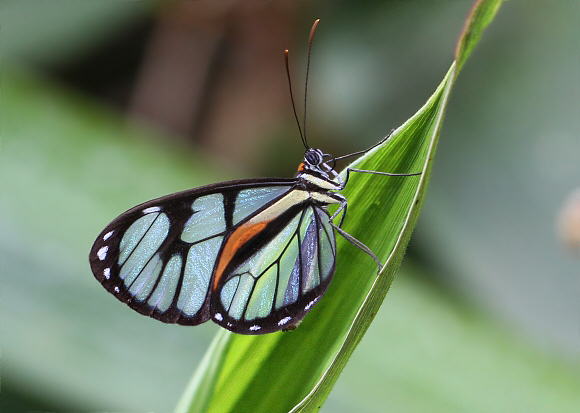
Introduction
The Ithomiini comprises of 376 known species, although it is likely that at least another 30 will be discovered in the near future. All are confined to the neotropical region. Ithomiines are unpalatable to birds, and are consequently mimicked in appearance by many other species. These include other unpalatable species (Müllerian mimics), not only from the Ithomiinae but also from several other butterfly families. There are also a large number of edible species (Batesian mimics) which have evolved similar patterns. Birds have the ability to memorize butterfly patterns and so learn to avoid eating noxious species, but are also fooled into ignoring similarly marked edible species.
Ithomiines are characterized by having small eyes, slender abdomens, and long drooping antennae that lack distinct clubs. Males have a plume of long androconial scales or ‘hair pencils’ on the costa of their hindwings. These are hidden from view when the butterflies are at rest, but are displayed when the wings are held open during courtship. Other Ithomiine characteristics include a very slow and deep wing beat, and a preference for inhabiting the darkest recesses of the forest understorey.
There are basically 2 types of Ithomiine. The first type are the black and orange-banded ‘tigers’, many of which are mimicked by other species due to their unpalatability to birds. The second type are the ‘glasswings’, recognized by their transparent or translucent wings, prominent veins, and orange wing margins. Many genera contain examples of both of these types, and in some cases an individual species may produce adults of both forms according to location.
Most novices find the Ithomiini very difficult to identify. Using only the patterns to identify species is very unreliable because there are so many similar species. Also many species produce a variety of different color forms according to locality and season. The best approach therefore is to use the hindwing venation and other anatomical features to identify the genus, and to then look at the wing patterns to short-list the likely species.
The genus Ithomia is believed to have evolved between 12-16 million years ago, at a time when the Andes were only about half their present height. The evolution of the individual species was probably a consequence of a major uplift in the Andes. This created a massive diversification of microclimates and habitats, thereby providing the stimulus for speciation.
Many of the 22 known Ithomia species have slightly bluish translucent wing membranes. They also have a small tuft of orange scales just behind the head. Males of Ithomia have a distinctive blister on the costa of the underside hindwings that corresponds with a patch of androconia (pheromone producing scales) on the upper surface. Ithomia hyala occurs as 3 named subspecies distributed from Costa Rica to Ecuador. The illustrated subspecies sincerus is endemic to Colombia. The Panama subspecies hyala is completely different in appearance, with translucent orange ‘tiger pattern’ wings.
Habitats
This species inhabits cloudforest at elevations between about 500-2000m.
Lifecycle
The eggs of Ithomia are typically white, and laid singly on the underside of leaves of Witheringia, Solanum, Acnistus and other Solanaceae. These foodplants are highly toxic to birds and other small vertebrates. At one time it was thought that the chemicals within them were accumulated by the larvae, and passed on to the adult butterflies, rendering them highly distasteful to birds.
Research by Edgar et al in the 1970’s and 80’s however revealed that the alkaloids found in adult Ithomiines and Danaines are sequestered from flower nectar and plant exudates, rather than being derived from the larval foodplants. Ithomia caterpillars are generally greenish and devoid of filaments but have a row of lateral tubercles. The pupae are chrome-silver, and suspended by the cremaster from leaves or stems. From a distance they can be mistaken for droplets of rain.
Adult behaviour
Like other Ithomiines, the butterflies spend long periods at rest on the foliage of small shrubs in the darkness of their rainforest and cloudforest habitats. They are extremely nervous, and if disturbed fly immediately, only to resettle on another nearby leaf. The flight is very slow, with characteristic deep wing beats. When feeding in the open they behave very differently – both sexes being very placid and reluctant to leave their flowers.
Males sequester pyrrolizidine alkaloids from Heliotropium, Tournefourtia, Myosotis (Boraginaceae), Eupatorium, Neomiranda and Senecio (Asteraceae). These chemicals confer toxic qualities to the butterflies which deter bird attacks. The chemicals are also used in the production of pheromones. Often the males of several Ithomiine species will gather together at communal leks, where they release these pheromones from hair-like androconial scales on the leading edge of their upperside hindwings.
These attract more males, which in turn release further pheromones. After a few days the lek may include 50 or more adults comprised of as many as dozen different species. Passing females are attracted to the leks by the complex fragrances.
Their presence stimulates the males to open their wings and release further pheromones that entice them into copulation. Females obtain sustenance from nectar, and also visit bird droppings which provide them with a source of nitrogen that assists with the development of their eggs.
